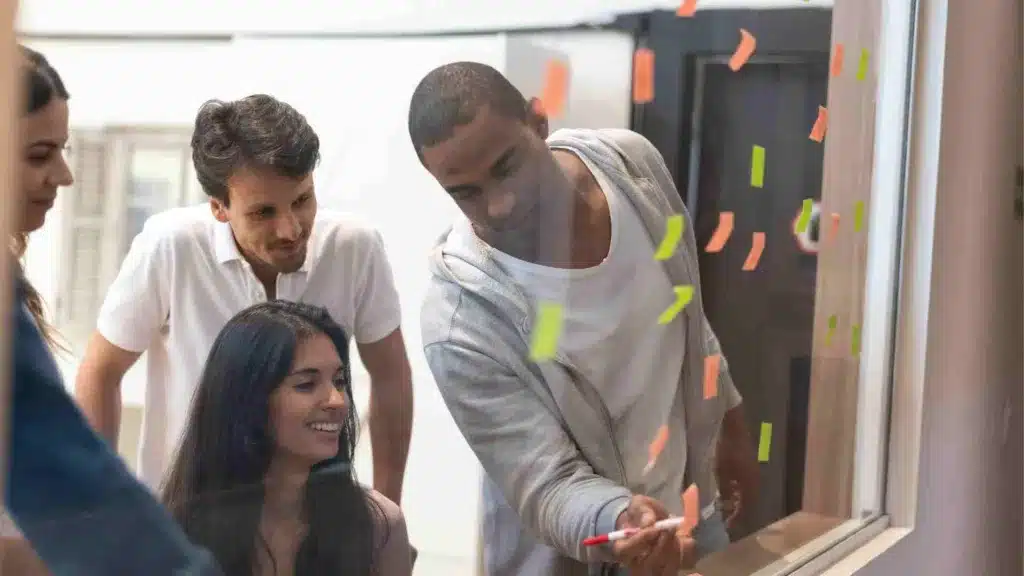Posted in Blog, Facilitation, Virtual Facilitation by Jo North
In this article, I’ll delve into the essentials of Design Thinking 101. You’ll discover what design thinking entails, why it’s important, and how it’s relevant to businesses of all shapes and sizes, across various sectors.
The beauty of design thinking lies in its ability to spur innovation in creating products that resonate profoundly with customers, giving your business a substantial competitive advantage.
So, we’ll embark on a journey encompassing an overview of design thinking, its historical underpinnings, and practical application methods. Our exploration doesn’t end there as then we’ll get into a comprehensive dissection of the various stages in the design thinking process.
I’ve also included a workshop agenda that covers every stage of the design thinking process, with an array of activities. This way, you can experiment with various design thinking workshops with your team.
Jump to Contents:
- Introduction to Design Thinking 101
- Five Stage Design Thinking Process
- Applications of Design Thinking
- Why Use Design Thinking in Your Organization?
- A Brief History of Design Thinking
- Challenges of Design Thinking
- Benefits of Design Thinking
- Deep Dive into the Five Phases of the Design Thinking Process
- The Importance of Collaboration in Design Thinking
- Design Thinking in Various Industries
- Design Thinking in Social Innovation: Addressing Human Needs
- Interesting Examples of UX Designers and Design Practitioners’ Stories
- Conclusion: Design Thinking as a Way of Life
Introduction to Design Thinking 101
What is Design Thinking?
The essence of design thinking lies in its creative problem-solving process, which is grounded on understanding and addressing people’s needs. It sets itself apart from other methodologies through its unique user-focused nature. Applicable to individuals and businesses alike, it can aid expansion, problem-solving, and competition, enhancing their ability to make a meaningful difference in the world.
Design thinking, while multifaceted, can be distilled into a few key elements. As presented by Tim Brown at IDEO and by Stanford D School, it embodies a human-centric approach to design-driven innovation, using a designer’s toolkit to address people’s needs. It goes beyond tackling problems to actively crafting desirable solutions for clients in creating new products, and in service design. Jeanne Liedtka from the Darden School of Business further underscores the significance of problem-solving and its inherent people-focused orientation.

The Council of Europe encapsulates design thinking as an intentional process to generate novel, meaningful solutions that yield positive impact, an idea echoed by Nigel Cross from the Open University who notes its practical, solution-oriented methodology. This underscores that design thinking is more than a theory – it’s a practical approach embedded in real-world problem-solving.
Design thinking is even utilized by non-competitive organisations like the NHS in the UK. At its heart, it involves adopting a designer’s mindset, with a focus on understanding and meeting customer needs. It’s a comprehensive method for creative problem-solving, equipped with its own toolkit, emphasising user involvement in the process. In a nutshell, design thinking is a powerful, practical, and user-centric approach to creative problem-solving of real-life problems. It has the potential to revolutionize how we tackle challenges in every aspect of life and business.

Ideo’s Phases of Design Thinking
The innovation business, IDEO, outlines a series of crucial design thinking phases.
The first phase centres around gathering inspiration, where the focus is on discerning the real needs of people, and figuring out how we can better assist our customers.
The second phase dives into the process of idea generation. Here, the challenge lies in breaking away from the conventional, transcending the status quo to conceive innovative ideas that genuinely cater to people’s needs.
The third phase is all about translating these abstract ideas into tangible prototypes. This phase involves crafting representations, examples, or mock-ups of the proposed ideas that can be tested and interacted with by customers. The goal here is not just to create, but also to effectively share the story behind these creations, inspiring action from the customers.
This iterative, human-centric approach is a key component of design thinking and an essential driver for innovation and problem-solving.

Five Stage Design Thinking Process
Moving beyond the phases of design thinking, there are five typical stages that shape the process.
The first stage, ’empathize’, necessitates a deep understanding of the customer – their thoughts, actions, feelings, and objectives.
The next stage is ‘define’, where we identify and articulate what we need to create for them, be it a product or service.
Following this is the ‘ideate’ stage where we generate ideas in alignment with the defined objectives.
Next comes ‘prototype’, which involves giving these ideas physical form for better understanding and evaluation.
The final stage is ‘test’, where these prototypes are put to use, and their performance is evaluated. The feedback received is then used to refine and possibly reiterate the entire process.
While these stages may seem sequential and linear, in reality, they’re often more fluid. There can be considerable back-and-forth movement between stages, reflecting an iterative loop rather than a straightforward path. This flexibility is a fundamental aspect of the design thinking process, accommodating constant refinement and adaptation.

Applications of Design Thinking
From sustainability and climate change challenges to human behaviors, design thinking can be instrumental in any scenario where a positive change is sought. This is particularly true when that change involves altering people’s behaviors. By understanding what individuals are doing, what they aim to achieve, and what drives their actions, we can design more effective solutions that align with these behaviors, fostering positive change.
Design thinking isn’t confined to product development; it’s also applicable in service design, business model innovation, organizational change, and even the introduction of new technology or processes in your business. Gaining a deep understanding of what your employees or colleagues need from these, how they’re currently using them, and how they might use them differently is crucial.
Problem-solving of any kind can benefit from the application of design thinking. It’s used in a range of sectors, including healthcare, education, public policy, and digital transformation.
Essentially, design thinking is a versatile tool with countless applications. Whether you’re seeking to provide a better experience for your customers, innovate within your field, or grow your business, design thinking can be a powerful method to achieve these goals.
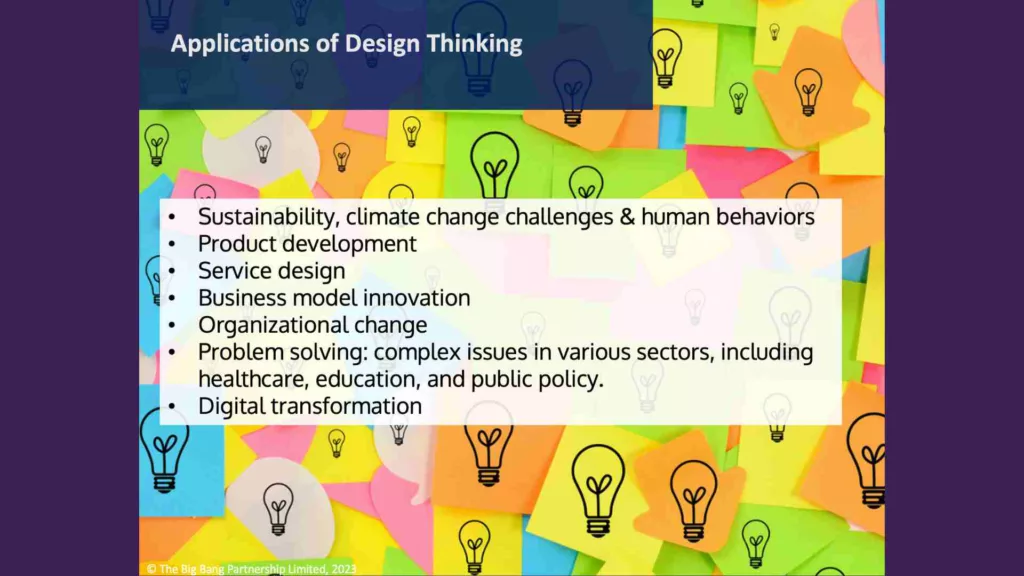
Why Use Design Thinking in Your Organization?
Why should you choose design thinking over other methodologies?
The answer lies in its human-centric approach. The success of any innovation hinges on people’s interest and investment in it. Do they care enough to purchase it, spend time with it, learn to use it? Since design thinking revolves around this human focus, it’s a catalyst for innovation that propels you forward.
Design thinking, being so attuned to users’ needs, also minimizes risk. By collaborating directly with the people who will use the product, service, or solution, you enhance its adoption rate and increase the likelihood of its success. This engagement from the early stages fosters enriched collaboration, making it an ideal strategy for uniting teams in problem-solving efforts.
Moreover, design thinking helps future-proof your business or organization. By honing skills that focus on understanding and serving user needs, you’re well-positioned to adapt as those needs evolve over time – a certainty in today’s rapidly changing world. Therefore, adopting a design thinking mindset is not just beneficial for current operations but also serves as a strategic investment for the future.
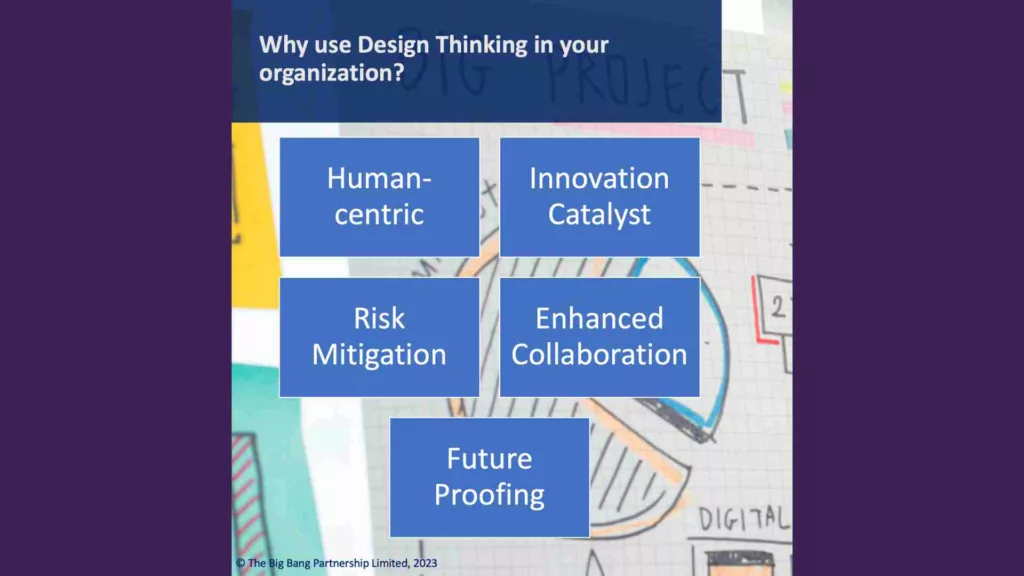
A Brief History of Design Thinking
Before we delve into how to practice design thinking, let’s take a brief look at its historical roots.
Creative problem-solving has always been inherent to us as a species, but it wasn’t formally documented and conceptualized as a process until the mid-20th century. Alexander Osborn, an advertising executive in the 1940s and ’50s, is credited with initiating this process. Seeking to instill creativity systematically within his agency, Osborn developed the Osborn-Parnes creative problem-solving method, which proved successful and was subsequently introduced into educational settings.
As we moved into the 1960s and ’70s, more visual forms of creative problem-solving started to appear, utilizing images, sketches, diagrams, and designs. The term “design thinking” truly began to take shape in the ’80s and ’90s, partly due to a book by architect Peter Rowe that examined the creative processes of architects. From that point forward, the concept grew progressively, becoming more prominent in the 2000s and 2020s, with institutions like Stanford and their D school championing the methodology.

Today, design thinking continues to evolve and expand. It’s widely employed in various sectors, notably in the technology field for app and website development, as well as for designing products and services. Its growth and application show no signs of slowing down, testament to its utility and effectiveness in a multitude of contexts.
Challenges of Design Thinking
While design thinking offers immense benefits, it’s important to acknowledge that it doesn’t come without its share of challenges. It’s not always a seamless journey, and you may have encountered some of these hurdles yourself.
Behaviors, Feelings, and Choices
For starters, the design thinking process can sometimes feel a bit personal and subjective, as opposed to the analytical approach many organizations are accustomed to. It emphasizes understanding people’s wants, needs, behaviors, emotions, and feelings, which can feel unusual in typically data-driven environments. While integrating analytical data with these human insights is essential, it can pose a learning curve for some organizations.
Exploration and Discovery
Moreover, design thinking encourages exploration and discovery instead of hurrying towards a solution. In our busy lives, the temptation to quickly find the most straightforward resolution to a problem is strong. But design thinking urges us to pause, explore less obvious options, and potentially unearth innovative solutions that push boundaries and spark creativity.
The Need to Be Comfortable with Ambiguity
Another challenge with design thinking is the necessity to be comfortable with ambiguity. The process might lead us into uncharted territory, creating a sense of disorder and chaos. Yet, it’s in navigating through this uncertainty where innovative solutions often emerge. If you’re implementing design thinking within a larger organization, expert facilitation can be incredibly helpful in guiding you through this process.
Yes, design thinking presents challenges, but it’s these very hurdles that make the approach so unique and rewarding, pushing us to think differently and fostering innovation.
Understanding the Limitations
Design Thinking emphasizes empathy, prototyping, and iterative learning, which can be incredibly valuable. However, it’s essential to recognize that this methodology is not a one-size-fits-all solution and can sometimes falter in specific contexts.
When Design Thinking Doesn’t Work
Several factors can limit the effectiveness of Design Thinking:
- Misalignment with Organizational Culture: A company culture that doesn’t value experimentation or tolerate failure can hinder the implementation of Design Thinking.
- Insufficient Understanding: Design Thinking is often misunderstood as a process that anyone can apply without training or understanding of its nuances, which can lead to ineffective application.
- Overemphasis on Innovation: Not every problem requires a novel solution. Sometimes, existing methods can effectively solve problems more efficiently.
Addressing Criticisms and Misunderstandings
While Design Thinking faces criticisms, it’s essential to remember that many stem from misunderstandings or incorrect application of the methodology.
How to Overcome The Challenges of Design Thinking
- Encourage a Culture of Innovation: Promote an organizational culture that values experimentation, accepts failure as part of learning, and encourages diverse perspectives.
- Educate: Proper training and education on Design Thinking can help avoid its misuse. Clear, comprehensive understanding of the methodology can ensure its successful implementation.
- Contextual Application: Recognize when Design Thinking is the right approach. Use it to tackle complex problems that need creative solutions, but don’t disregard established methods when they’re more appropriate.
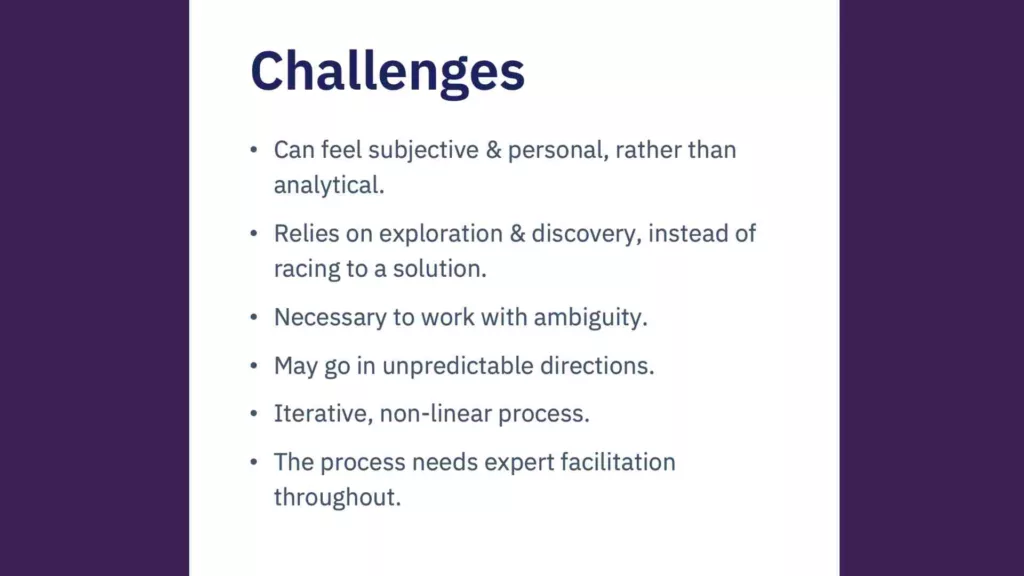
Benefits of Design Thinking
The benefits of design thinking are significant and multifold, and we’re going to delve deeper into understanding them.
Customer Focus
At its core, design thinking emphasizes a strong customer focus, helping you to differentiate your business and foster innovation. This robust approach encourages you to generate novel ideas and solutions that you might not have considered otherwise, thereby pushing the boundaries of conventional thinking.
Mitigating Bias
One substantial advantage of design thinking is its potential to mitigate bias and remove barriers that often hinder successful innovation. This is mainly due to the process’s relentless user-centric focus, which keeps the needs, wants, and expectations of your customers at the heart of the innovation process.
Dynamic Process
Although at times, the process of design thinking might seem chaotic and unstructured, it’s essential to remember that this perceived disorder is an integral part of the process. This seeming chaos often births the most innovative ideas. By embracing this dynamic, you’ll ultimately break through and achieve concrete outcomes.
Accessible and Relevant to All
Design thinking is an approach accessible to anyone and can involve all members of an organization. All you need is a challenge or a problem that needs addressing.
Permission to Think Differently
One of the most empowering aspects of design thinking is that it gives participants the permission to think differently. This freedom stimulates creativity and encourages unconventional thinking, leading to extraordinary results. By opening your mind to this method, you’re allowing yourself the chance to unlock innovative solutions and ideas that could significantly transform your business.
Better Outcomes for Business
In the business worlds, competitive advantage and success comes from solving customers’ problems well, and always staying relevant. Design thinking directly works to support both of those.
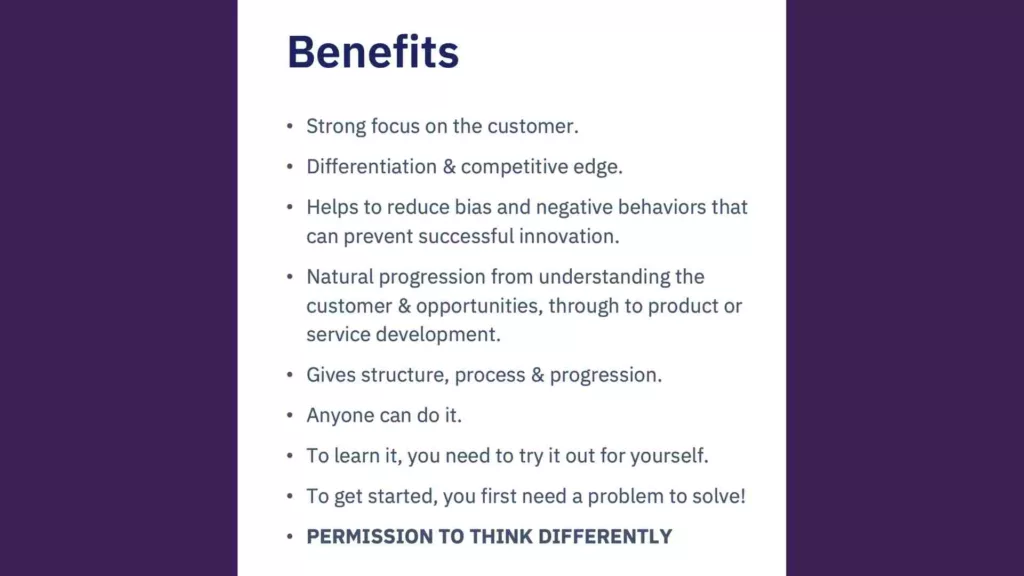
Deep Dive into the Five Phases of the Design Thinking Process
Now let’s do a deeper dive into applying design thinking in practice, by delving into each of its distinct stages.
1. Empathize: Understanding the User. The Design Thinking ‘First Step’
The first step of design thinking revolves around empathy – understanding the needs and concerns of your end users. This can be achieved by spending time observing your target audience, figuring out their routines, unmet needs, and questioning why they do what they do. Look for areas of friction or difficulty and find out how these issues can be mitigated.
Design Thinking Example: Bank of America
Consider the case of Bank of America who, through close observation of customers’ spending habits, discovered an opportunity to develop an automatic savings app. This app rounds up purchases to the nearest dollar and transfers the difference into a savings account. The bank identified a need and fulfilled it through innovation, creating an entirely new product.
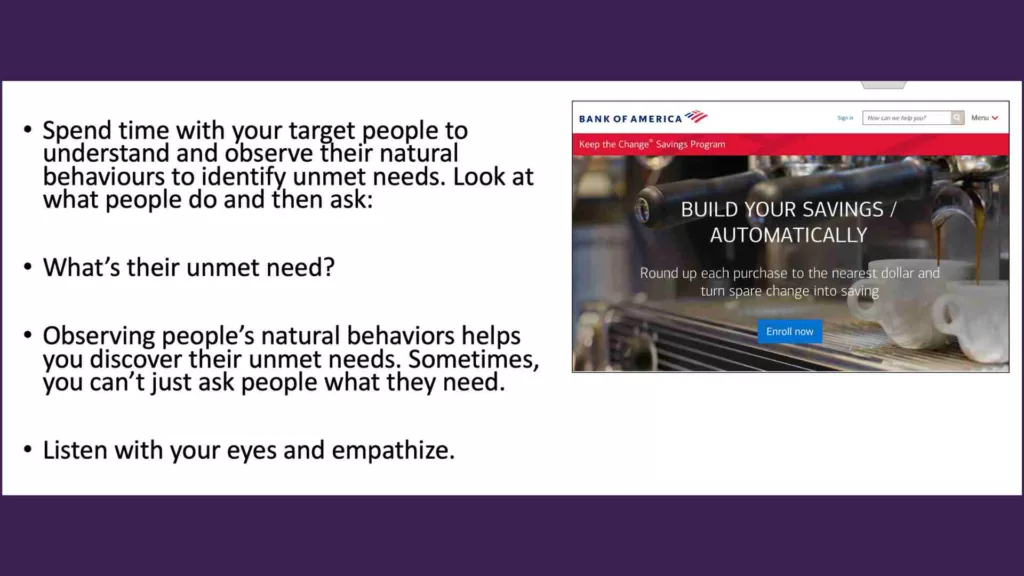
Design Thinking Example: Manufacturing
Similarly, during a visit to a modern manufacturing plant, it was noted that a worker was manually recording certain data next to a state-of-the-art machine. This led to the realization that the machine’s software design was lacking an essential feature. The issue was rectified by integrating the required feature into the software, ultimately streamlining the production process.
The Power of Observation
The crux of design thinking lies in watching closely, listening attentively, and tuning into what’s happening around you to improve things.
Some practical ways to practice observation include looking for things that reduce your customers’ or colleagues’ productivity, identifying workarounds or “hacks” they’ve developed, noting what matters most to them, and paying attention to their body language. Also, remember to look for the unexpected. When you engage closely with customers or colleagues in this way, you often uncover areas needing improvement, which forms a great starting point for the design thinking process.
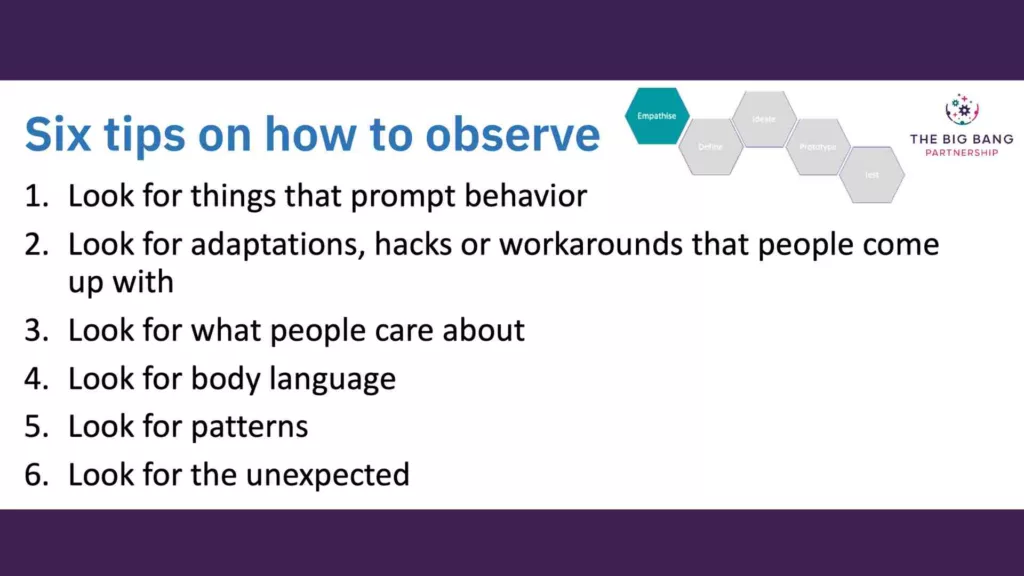
Bug Listing
One effective method to begin this process is by asking your team to list out all the things that bug them about a product or service. This allows them to vent their frustrations and also provides insights into what could be improved. After the bug list is prepared, encourage them to explore potential solutions, shifting the conversation from problems to positive exploration of improvements.
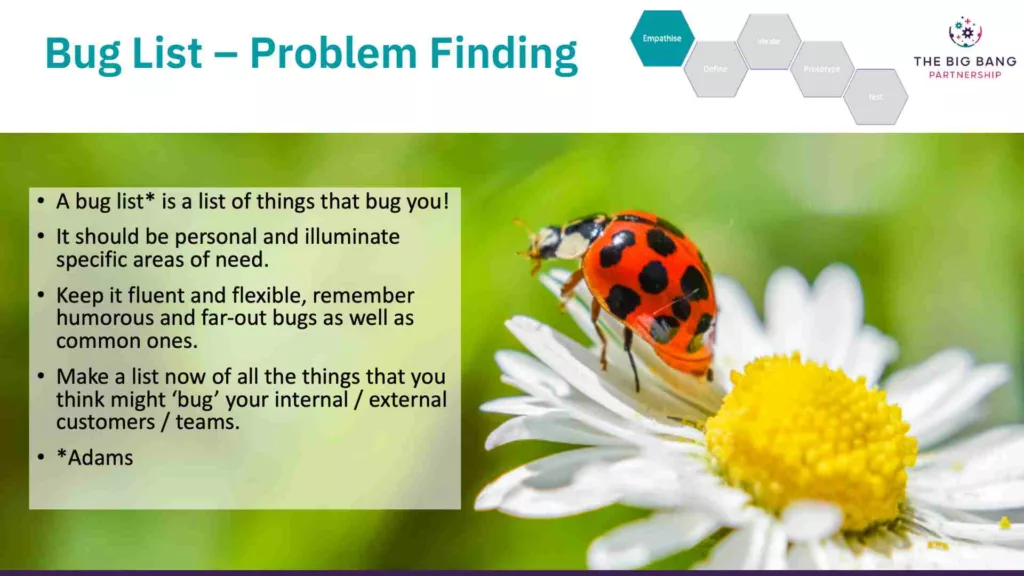
Ask Probing Questions
As you investigate user behavior, ask probing questions about why they do things a certain way. Moving from the concrete “what” and “how” to the emotional “why” can yield valuable insights. You can then use these insights to improve your product or service, creating a better experience for your customers.
Extreme Users
Consider looking at extreme users as well. These are people who use your product or service in innovative ways or use them more frequently than the average user. You might glean some fresh ideas from their usage patterns, which you can incorporate into the mainstream product or service, enhancing its appeal.
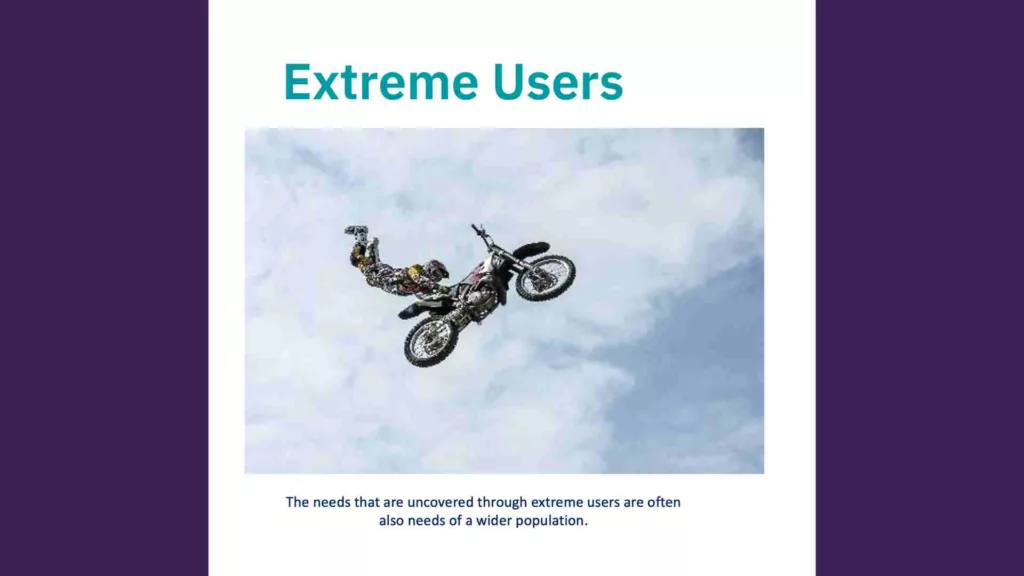
Empathy Map
Another useful tool to capture all these insights is an empathy map, a framework for understanding what your customers are thinking, doing, feeling, and saying when they engage with your product or service. It helps identify areas where you can improve the user experience. You can also map out their journey, looking at all touchpoints and finding ways to improve each one.
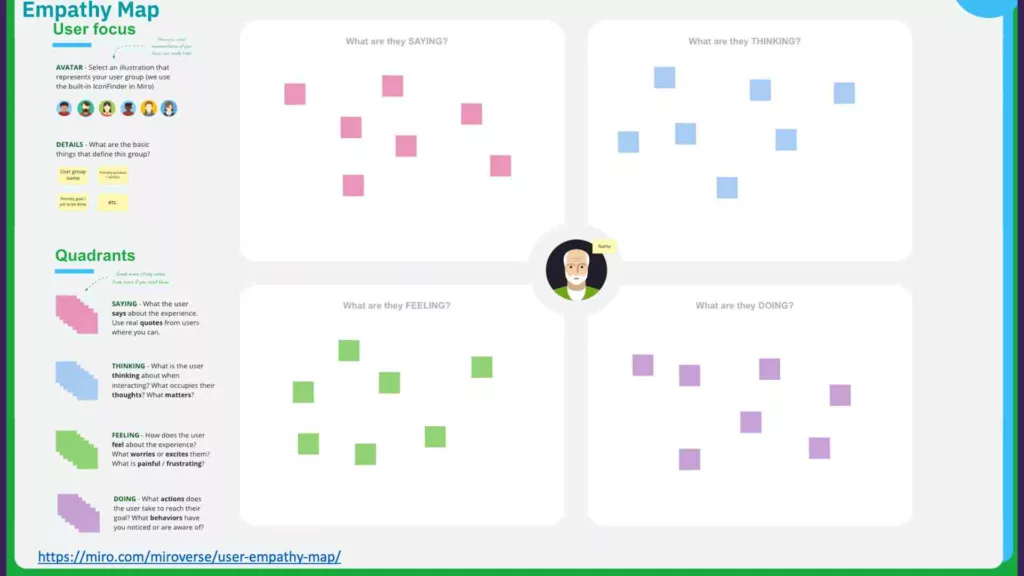
User-centric Approach
Don’t just rely on surveys or social media polls to understand your customers. While these tools can be useful, they often miss the nuances of customer behavior and needs, especially those that are subconscious or unexpressed. To truly understand your customers, you need to do targeted user research and observe them in action, which will help you think differently and more creatively about your approach.
Customer Journey Mapping
Customer journey mapping is also an excellent activity for gaining invaluable user insights. Click here for a detailed step-by-step guide on how to facilitate customer journey mapping activities in your design sprint.
2. Define: Articulating the Problem
After the phase of empathy, where an understanding of the customer’s problems and areas of potential innovation is gained, the next critical step is to clearly define the challenge. To miss this step would be to overlook an essential part of the process. For additional, free resources on formulating an effective challenge or problem statement, check out the resources page, here on our website.
Point of View (POV) Statement
The task at hand involves constructing a Point of View (POV) statement. This is also known as a ‘problem statement,’ ‘sprint mission’, or ‘challenge statement’.
The structure of a POV statement typically follows this pattern: ‘The user (define who the user is) needs to (define what they need to do) because (provide a surprising insight).’
Let me provide you with a practical example that I experienced. During an innovation sprint at the Northumbrian Water Innovation Festival, which was in partnership with the NHS service in the North East of England, the goal was to devise ways to encourage people to drink more water and prevent avoidable health complications.
Our team developed the following POV statement: ‘Elderly people who don’t stay hydrated need to enjoy water consumption more because their dislike of drinking water presents serious health risks.‘
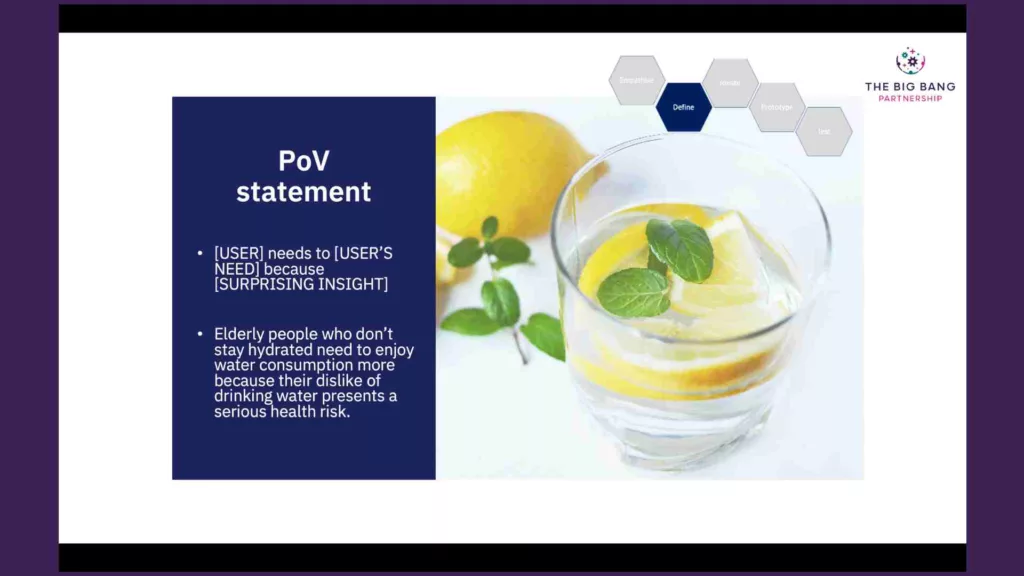
This statement underscores the need to improve water consumption enjoyment for a specific user group—elderly people—not due to any issues with the supply or quality of the water, but because they just didn’t enjoy drinking water. The avoidance of dehydration-related health risks was a significant reason behind this need.
Similar statements have also influenced innovation in other scenarios, inspiring creations like super-hydrating jelly sweets that appeal to our target user group.
By keeping our focus on such specific needs and insights, we can come up with innovative solutions and make significant strides in improvement. I hope this serves as a helpful example of how to craft an effective POV statement.
3. Ideate: Generating Solutions, ‘Creative Ideas’
After crafting a precise Point of View (POV) statement, it’s time to move on to the ideation stage.
The goal of ideation is straightforward—generate a multitude of ideas. Remember, the route to a great idea often involves navigating through numerous other ideas, many of which may not be viable. Still, within the volume of ideas, you’re bound to discover some gems.
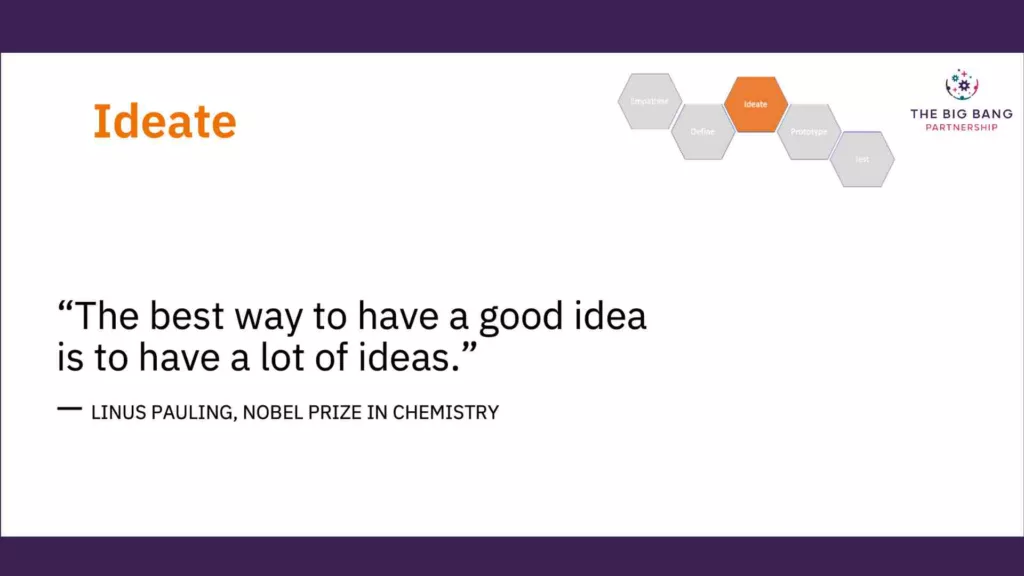
Creative Warm Up
A warm-up exercise I like to initiate with participants involves redesigning something commonplace. For instance, consider the chair you used in school. Think about the countless hours spent sitting on it and ponder how you might redesign it to enhance its functionality or comfort. Sketch the design in just a few minutes. This task not only sparks creativity but also encourages a focus on user experience.
Product designers often utilize this approach, incorporating features like wheels for mobility, added storage, improved comfort, or even workspace for a laptop.
Creative Ideation Methods
This sort of warm-up serves as a springboard for ideation and can be particularly useful before diving into standard techniques used in design thinking, such as the SCAMPER method (Substitute, Combine, Adapt, Modify, Put to another use, Eliminate, Reverse).
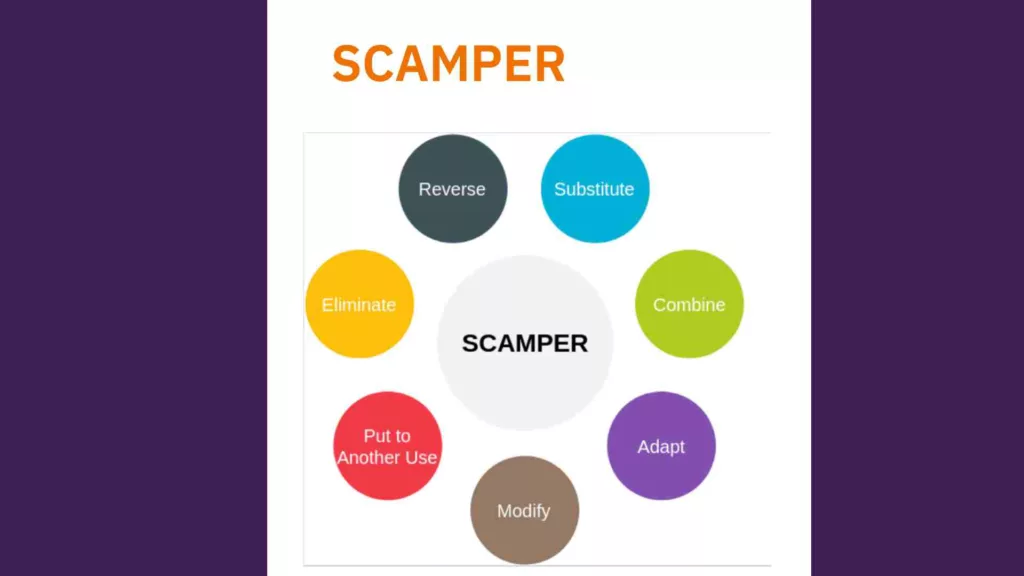
Another method I favor is “Inspired by Excellence.” It involves identifying places where excellence exists or individuals who excel at what they do. By mapping out what they’re doing right, we can glean learnings and generate diverse ideas.
Sometimes, to make things more interactive, I ask participants to choose a random number, each corresponding to a different person or organization—Lady Gaga, Apple, Amazon, Michelle Obama, Walt Disney, NASA, and more. We then explore how these entities might tackle the challenge at hand, which often leads to the discovery of innovative solutions.
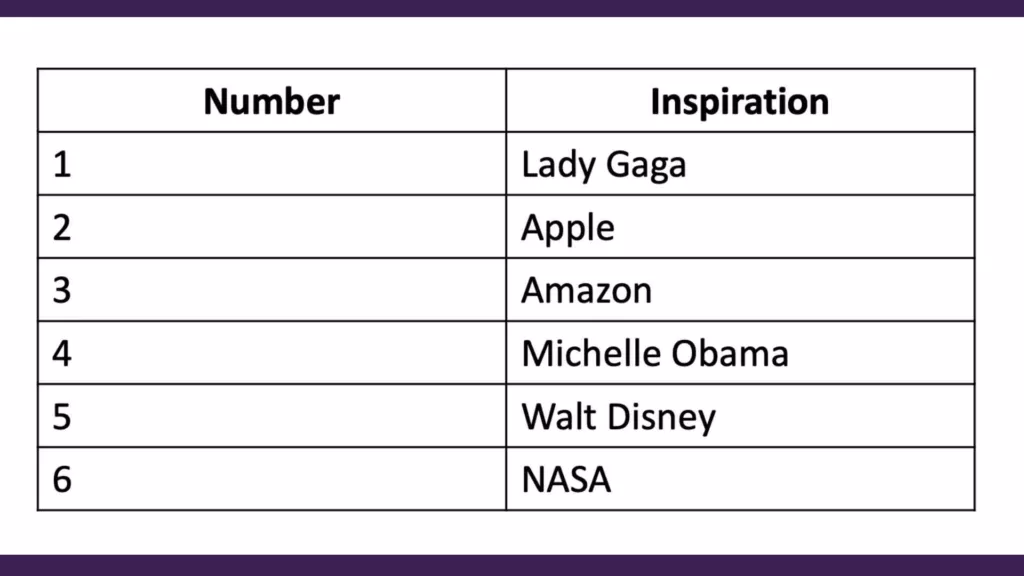
Creative Mash-up
For a creative twist, consider a mash-up activity. Assign each idea from the SCAMPER activity a letter and each idea from the “Inspired by Excellence” activity a number. Then, pair these ideas in unique ways to spark unconventional solutions.
For instance, if you’ve generated 10 ideas from each activity, label SCAMPER’s ideas A-J and “Inspired by Excellence’s” ideas 1-10. Then, pair them up in random combinations like A4, C1, D3, and so on, creating a grid of mix-and-match ideas. It’s an engaging exercise that extends creativity even further.
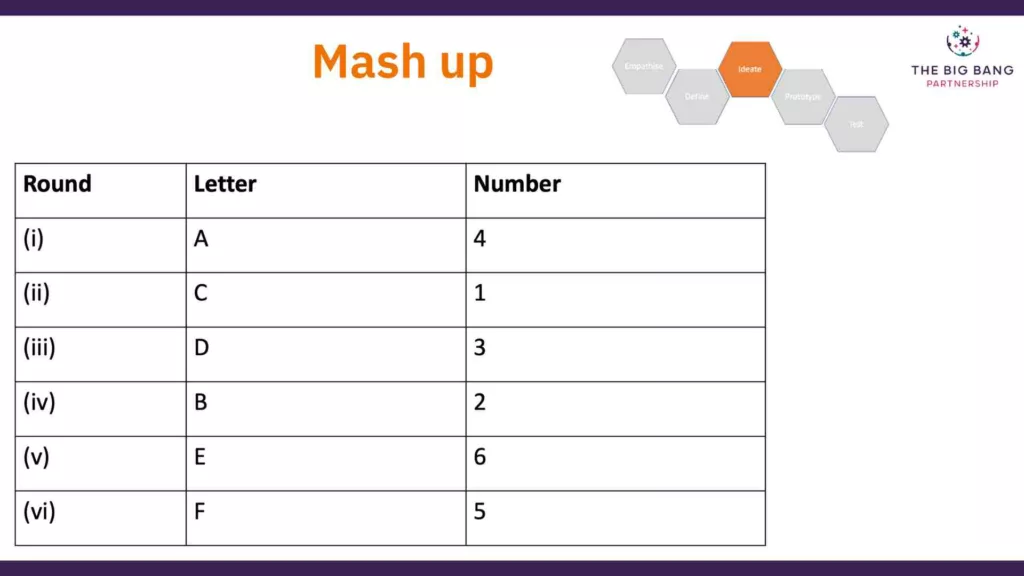
Crazy Eights
If you prefer a more straightforward approach, consider using the Crazy Eights technique, which involves dividing a page into eight sections and spending a minute on each to quickly sketch ideas related to your POV statement. These could be eight unique ideas or variations of a single concept.
You can find more brainstorming activities and tips here.
Idea Prioritization
Once your ideation session yields an array of ideas, you must undertake a prioritization exercise. Evaluate each idea based on its potential impact and the difficulty of implementation. Identify the best ideas for further development, and think about how to refine and shape them.
Generative Questions
Generative questions in design thinking are open-ended questions intended to inspire creativity, encourage deeper thinking, and broaden the scope of potential solutions during the ideation phase of the design thinking process. They are designed to generate many diverse ideas rather than converging on a single answer.
Generative questions are often framed around “How might we…?” or “What if…?”. They aim to stimulate innovative thinking and keep all possibilities open for exploration.
For instance, if you’re working on improving the user experience of a mobile app, instead of asking “How can we fix the bugs in the app?”, which is a specific and directive question, you might ask “How might we make the app experience more enjoyable for the user?” This is a generative question that opens up a wide range of possible solutions beyond just fixing bugs, such as enhancing the app’s interface, adding new features, or personalizing the user experience.
Generative questions are powerful tools in design thinking because they:
- Encourage ideation and creativity by challenging assumptions and promoting outside-the-box thinking.
- Stimulate discussions that can reveal deeper insights about user needs and desires.
- Help to shift the focus from problems to opportunities for innovation.
- Enable teams to explore a wider range of potential solutions.
4. Prototype – Building and Testing Solutions
The subsequent phase after ideation is prototyping.
The essence of prototyping is to build a representation of your concept. It can range from a simple construct made of cardboard and household items to a virtual mock-up of an application. The aim is to create a tangible representation of your proposed solution.
Determine Your Minimum Viable Product (MVP)
Before delving into the prototype, it’s essential to determine your Minimum Viable Product (MVP)—a version of your solution with just enough features to satisfy early customers and provide feedback for further product development. This concept means stripping away the bells and whistles to focus on the core functionality. Overcomplicating your MVP can make it harder to test with customers and may result in wasted resources.
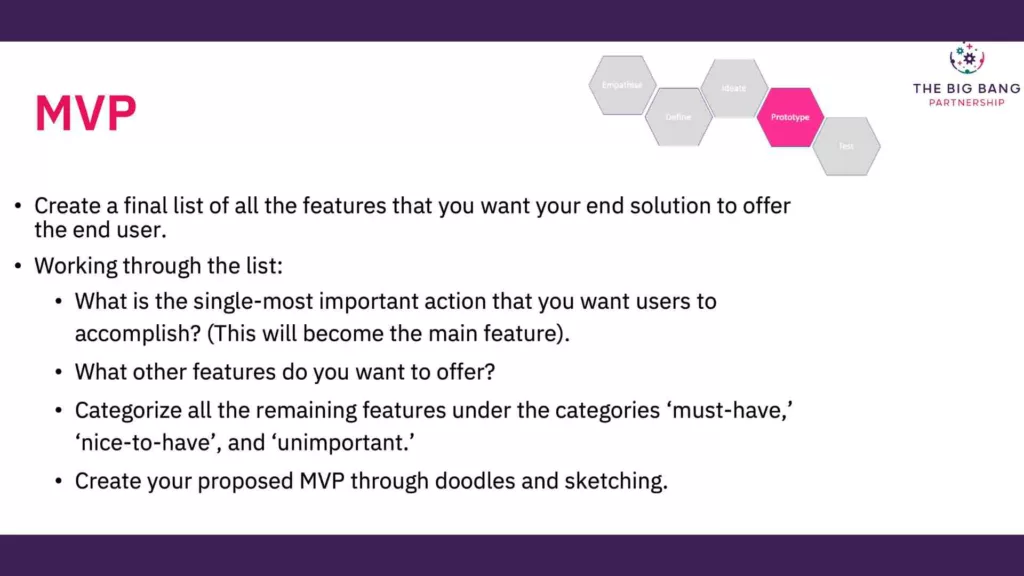
When shaping your MVP, compile a list of all the features you envision your final solution will offer. Determine the most crucial action you want your users to achieve—this will be your main feature. Subsequently, categorize the remaining features as must-haves, nice-to-haves, and unimportant ones. Your prototype should primarily focus on the must-haves. You can find more tips on how to create an MVP in your design thinking sprint here.
Sketches and doodles are often helpful in this stage, offering a quick, low-cost way to visualize your MVP. Once you’ve honed in on your MVP, proceed to build your prototype. You might utilize a method known as “Wizard of Oz” prototyping. This involves creating an illusion of a fully functional system when, in reality, it is being operated manually behind the scenes. This technique is low-cost, low-risk, and provides valuable user feedback.
Service Prototyping
Sometimes, if you’re designing a service, creating a physical prototype might be challenging. In such instances, crafting a story can effectively depict the user experience. Focus on a character-driven narrative with your customer at the center, incorporating elements of action, conflict, and transformation, much like any compelling tale. Be as detailed as possible and consider using tools like whiteboard apps to animate your story and bring it to life.
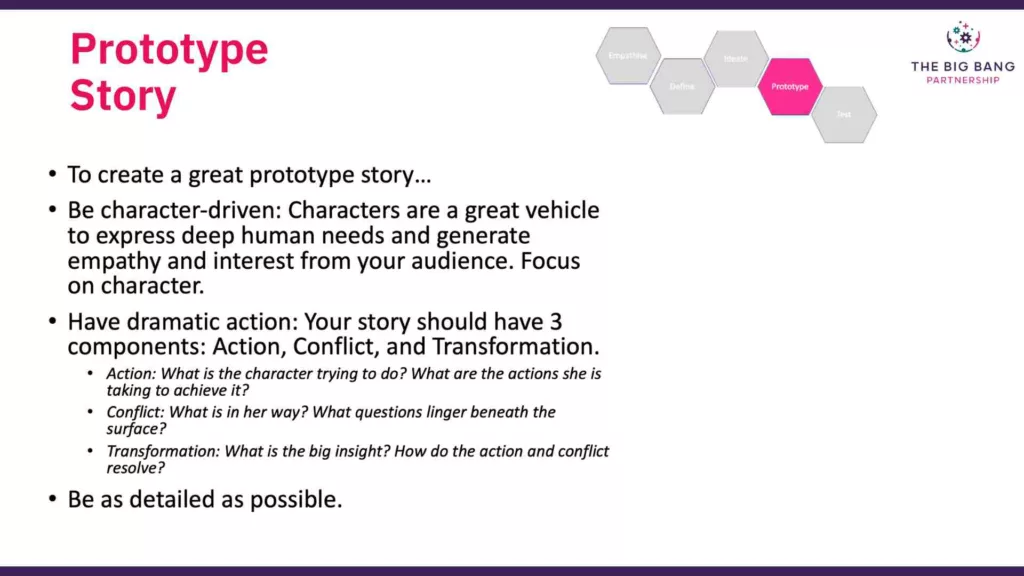
Alternatively, consolidate your solution sketches or the best parts of your Crazy Eights ideas into a single comprehensive solution sketch. This provides a clear, visual depiction of how your solution would function in practice.
Prototyping is an Iterative Process
Remember, prototyping is not a linear process. There may be several iterations involving going back to the ideation phase or revisiting the empathy stage. This is a natural part of the process and essential to the research and development phase.
5. Test: Evaluating Effectiveness
When you’ve arrived at the testing phase with your prototype, your primary objective is to discern whether your solution is desirable, feasible, and viable. You need to confirm that it is addressing a real need and that your solution has not strayed from the initial target identified during the empathy stage.
Assessing feasibility means verifying that your concept can technically be realized, and if applicable, ensuring it has the potential to surpass competitors. In addition, it’s crucial to examine if there is a viable business model underpinning your product or service.
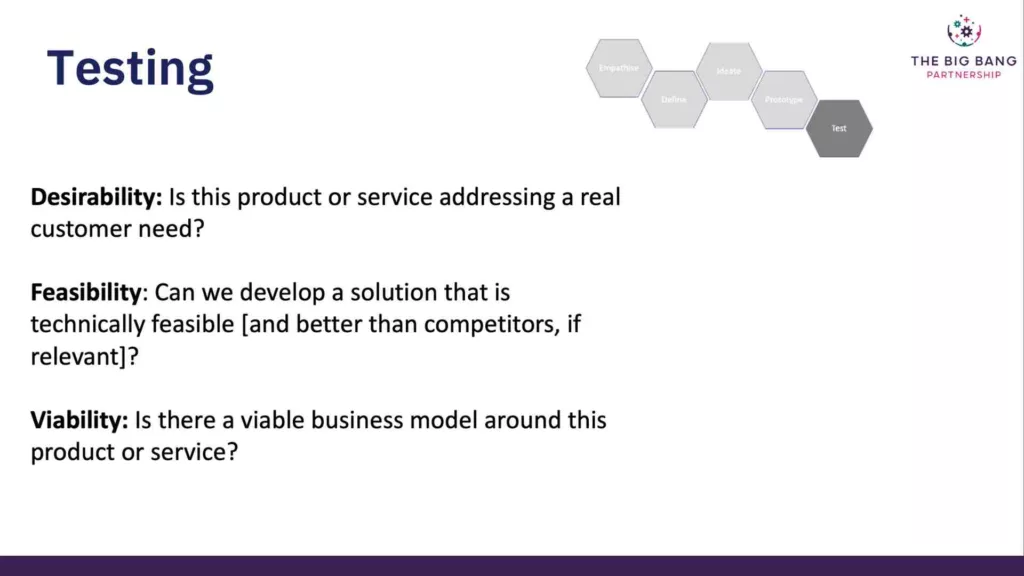
When conducting these tests, it’s important to involve actual customers rather than proxies who you believe understand the customer’s needs. This is because often, our preconceived notions may diverge from the real situation.
Encourage your customers to provide feedback based on the framework of “I like,” “I wish,” and “What if.”
Have customers voice what they appreciate about the prototype with “I like” statements. To uncover potential improvements, ask them to express their desires with “I wish” statements. Lastly, with “What if” questions, you can probe further into their reactions towards hypothetical modifications or features, thereby helping you refine your solution further.
Here are some more ideas for testing your ideas.
The Importance of Collaboration in Design Thinking
Cross-Functional Teams and Diverse Perspectives
The magic of Design Thinking comes to life when it’s being carried out by high-performing, cross-functional teams.
It’s not just about having a ‘design strategist’ at the helm, but about creating a collaborative innovation environment where team members with different backgrounds come together to share their unique perspectives. These diverse insights provide a richer understanding of the problem at hand and spark innovative solutions that wouldn’t surface in a homogeneous group.
The benefits of cross-functional teams in Design Thinking are multifold, enabling a dynamic exchange of ideas and fostering a culture of mutual respect and learning. Each team member contributes their unique skill set, creating an amalgamation of perspectives that catalyzes truly breakthrough thinking and enriches the final product or service. Remember, diversity isn’t an optional extra in Design Thinking, it’s the fuel that propels the engine of innovation.
Facilitation Tips for a Collaborative Environment
Facilitating a collaborative environment for design thinking is a bit like orchestrating a grand symphony; it requires keen attention, thoughtful direction, and an openness to the occasional unexpected note. Here are some facilitation tips to help you to set the stage for successful collaboration:
Set the Tone
As a facilitator, you’re the conductor of this performance. The atmosphere you create will play a key role in setting the rhythm for your team. Embrace curiosity, encourage open-mindedness and foster a space where creativity isn’t just allowed, but actively encouraged.
Value Everyone’s Input
Each team member brings their unique perspective to the table, drawn from their varied backgrounds. Make sure each voice is heard and valued. Encourage everyone to share their thoughts, and remember, there are no ‘bad’ ideas in brainstorming.
Promote Active Listening
Collaboration is a two-way street. Encourage your team members not just to share their thoughts but to actively listen to others. This promotes empathy and understanding, core pillars of design thinking.
Clarify Goals and Roles
Clear communication is the lubricant that keeps the gears of collaboration turning smoothly. Ensure everyone understands the overall goal, their individual roles, and how they all fit together in the broader context.
Embrace Diverse Thinking
Diversity is the lifeblood of innovation. Encourage your team members to approach problems from different angles, and value the richness this brings to the ideation process.
Foster a Safe Space for Risk-Taking
Encourage your team to step outside their comfort zones and to embrace bold, unconventional ideas. Remember, in the realm of design thinking, sometimes the biggest risks yield the greatest rewards.
Encourage Feedback and Reflection
Constructive feedback and reflection are essential parts of the iterative design thinking process. Facilitate spaces where your team can provide and receive feedback in a respectful and constructive manner.
By following these steps, you can create an environment that not only cultivates collaboration but also celebrates the diversity of thought, setting the stage for breakthrough ideas to flourish.
Make sure you have a look at my article here for 10 lesser-known design thinking tips to help you advance your skills.
Design Thinking in Various Industries
Design Thinking in the Tech Industry
Unleashing Innovation: How Microsoft’s Security Organization Harnessed Design Thinking
As digital transformation progresses, the role of security has become increasingly crucial in the tech industry. Microsoft’s Security Organization serves as an exemplar in how to effectively use design thinking to improve processes and end-user experiences. This approach has played a pivotal role in Microsoft’s continued success, illustrating how the concept extends beyond mere buzzword status to become a powerful business tool.
Microsoft’s Security Organization, in their quest for improved cybersecurity measures, embraced design thinking as a guiding methodology. Recognizing the importance of holistic problem-solving, they sought to cultivate a human-centered approach to the traditionally technical field of cybersecurity.
Empathy
To initiate the process, the organization first invested in understanding their end-users deeply, essentially empathizing with the people who would interact with their security systems. This included security admins, developers, and everyday users, each group having unique needs and challenges.
Problem Definition
Following this empathy stage, the digital product designer team in Microsoft defined the problem space. This involved identifying the pain points of each user group, recognizing the gaps in existing solutions, and framing these in the context of actionable problem statements.
Ideation
The team then moved on to the ideation phase, the heart of design thinking where the most exciting brainstorming happens. Leveraging their diverse backgrounds, team members proposed a myriad of solutions to address the defined challenges.
Prototyping
The work didn’t stop there. To bring their ideas to life, Microsoft’s designers rolled up their sleeves to develop prototypes, embodying the principle of “show, don’t tell.” These varied from clickable mock-ups to interactive simulations, bringing an element of tangibility to their proposed solutions.
Testing
Last, but not least, came the testing phase. The team rigorously tested their prototypes with real users, incorporating the ‘I like, I wish, What if’ feedback approach. They meticulously collected data on user reactions and iterated their designs accordingly, always keeping the user experience at the forefront.
Summary
Microsoft’s design thinking experiment was not just a creative detour, but an integral part of their strategy that yielded impressive results. They successfully created a more user-friendly security experience that balances stringent protection measures with ease-of-use, thereby reducing friction for end-users.
Moreover, this process resulted in high-performing cross-functional teams, as design thinking naturally promotes inter-departmental collaboration and empathy.
This case study of Microsoft’s Security Organization underscores the transformative potential of design thinking. When correctly applied, design thinking can yield significant dividends, including improved user experiences, increased efficiency, and ultimately, superior products and services. As Microsoft’s experience has demonstrated, design thinking is a winning strategy for tech companies seeking to navigate the complexities of today’s digital landscape.
Design Thinking in Healthcare
Infusing Innovation into Healthcare: The Power of Design Thinking in Clinical Practices
The healthcare sector stands as a testament to the transformative power of design thinking, with various institutions incorporating this approach to foster significant advances. Among these trailblazers are Tufts Medical Centre and Ohio State University College of Nursing, whose innovation programs have reimagined traditional healthcare systems.
Design Thinking at Tufts Medical Centre and Tufts University School of Medicine
At Tufts Medical Centre and Tufts University School of Medicine, the embrace of design thinking gave rise to their Healthcare Innovation Program. The aim of this initiative is to create patient-centric solutions that will improve care delivery and clinical practice outcomes.
The first stage, empathy, saw clinicians, medical students, and other healthcare professionals engage deeply with patients, understanding their needs, concerns, and experiences within the healthcare system. This approach fostered a comprehensive perspective on the challenges faced by the patients and the clinical team alike.
Following empathy, the team defined their key problems, outlining the gaps within the existing care delivery models. The challenge was to refine these issues into actionable problem statements, ultimately guiding the brainstorming phase.
Ideation followed, where the diversity within the team resulted in a plethora of innovative solutions. From enhancing patient-provider communication to streamlining medical procedures, a variety of proposals were brought to the table.
The prototypes developed ranged from new technological tools to revised patient interaction protocols. Each of these prototypes aimed to enhance the patient experience and improve clinical outcomes.
Finally, these prototypes were tested within the actual clinical settings, with patients and healthcare professionals providing invaluable feedback. The process of iteration was a constant, with the team refining their solutions based on real-world input.
Design Thinking at Ohio State University College of Nursing
Over at the Ohio State University College of Nursing, a similar approach to design thinking was adopted.
Recognizing the importance of effective health systems, the College initiated an innovation program that targeted healthcare delivery.
The process began with empathetic interaction with patients, nurses, doctors, and other stakeholders. Defining the problem was the subsequent step, which identified key areas for improvement, such as patient care and administrative processes.
The ideation phase involved a cross-disciplinary team proposing unique solutions to improve healthcare outcomes. Prototyping these ideas brought forth tangible models that encapsulated their innovative healthcare strategies.
These prototypes were tested in relevant environments, refined based on feedback, and adjusted as necessary to ensure they were effective, efficient, and suitable for their intended users.
The results of these design thinking initiatives have been remarkable. They have not only improved patient experiences and healthcare delivery but also fostered an environment of innovation within these institutions. The design thinking approach, as shown by Tufts and Ohio State University, offers a promising path for other healthcare institutions aiming to reinvent their practices in a human-centric manner.
Design Thinking in Education
Revolutionizing Learning through Design Thinking: A Modern Approach to Higher Education
Modern design thinking methodologies are transforming the way we approach higher education. With its empathetic, iterative, and solution-oriented nature, design thinking is not only influencing the curriculum but also the physical design of learning spaces, aiming to foster an optimal learning environment for students.
Higher education institutions across the globe are adopting this approach to revamp their educational strategies and structures. The influence of design thinking can be seen in everything from the layout of lecture halls to the methodologies applied in advanced research projects.
Modern School Design and Design Thinking
The heart of design thinking—empathy—is strongly reflected in the modern design of educational spaces. Today, traditional classrooms are being reimagined to accommodate various teaching styles and learning preferences.
In these modern settings, classrooms are no longer rigid, with fixed rows of desks facing a single point of instruction. Instead, they are becoming more flexible, featuring movable furniture and open spaces that promote collaboration and active learning. Technology is integrated seamlessly, reflecting the digital native reality of today’s students.
Quiet areas for independent study coexist with bustling collaborative spaces. This caters to different learning preferences, enabling students to choose environments that align with their preferred study methods.
Impact of Design Thinking on Higher Education Curriculum
Beyond the physical environment, design thinking is influencing the educational approach of higher education institutions. Courses and projects now promote critical thinking, problem-solving, collaboration, and innovation—all key elements of the design thinking process.
For instance, students are encouraged to empathize with real-world situations and stakeholders. They define problems, ideate potential solutions, prototype their ideas, and engage in continuous testing and iteration. Such projects cut across multiple disciplines, emphasizing the interconnectedness of today’s world and the importance of cross-disciplinary collaboration.
Design thinking in higher education is preparing students for a modern workforce that values innovation and human-centered problem-solving. Students are not only gaining knowledge in their respective fields but also developing essential skills that will allow them to navigate the challenges of their future careers effectively.
Design Thinking in Social Innovation: Addressing Human Needs
In the realm of social innovation, design thinking is making its mark as a highly effective tool. This human-centered approach to problem-solving is instrumental in developing solutions that directly address people’s needs, often in transformative ways.
Design Thinking: Empathizing with Human Needs
The heart of design thinking lies in empathy. By focusing on the lived experiences, needs, and challenges of people, this approach allows innovators to identify potential opportunities for social impact that might otherwise remain unnoticed.
For example, an innovative project may start with deeply understanding the experiences of people living in underserved communities, identifying their needs and challenges, and then ideating and prototyping potential solutions. These solutions could range from improved access to clean water, creation of community-based learning resources, or platforms that enhance local economic opportunities.
Case in Point: Design Thinking and Social Innovation in Action
Several organizations have successfully used design thinking to address complex social issues.
Examples are the development of the Embrace Warmer, a low-cost incubator for premature infants in developing countries, and OpenIDEO, an online platform that uses design thinking to solve global challenges.
These initiatives begin by empathizing with the affected communities to deeply understand their needs. Next, they define the problem from the users’ perspective, brainstorm innovative solutions, create prototypes, and iterate based on feedback.
The Impact of Design Thinking in Social Innovation
Through design thinking, innovators can tailor social interventions to the people they aim to serve. They are empowered to create solutions that are not only effective but also contextually appropriate, sustainable, and welcomed by the communities involved.
By keeping human needs at the center of the process, design thinking leads to social innovations that truly make a difference. The result is the creation of products, services, and initiatives that enhance people’s lives and promote societal well-being.
Interesting Examples of UX Designers and Design Practitioners’ Stories
UX design, or User Experience design, is an exciting and ever-evolving field. It requires a perfect blend of creativity, empathy, and analytical thinking. Now let’s delve into the inspiring stories of some renowned design practitioners in the realm of UX.
Don Norman
Don Norman is the very person who coined the term “User Experience”. Norman’s work as the Director of The Design Lab at the University of California, San Diego, has set numerous standards in the field. His book, “The Design of Everyday Things,” is a seminal work that emphasizes user-centered design.
Kim Goodwin
Kim Goodwin, author of the book “Designing for the Digital Age,” has made a significant impact on UX design. Her work focuses on integrating business objectives and user needs. Goodwin’s techniques, especially her scenarios and persona development methods, have become a mainstay in the design process of many UX practitioners.
Mike Monteiro
Mike Monteiro, co-founder of Mule Design, is an influential figure in UX design. Besides his design work, he’s made his mark through books such as “Ruined by Design,” where he discusses the ethical responsibilities of designers. Monteiro is known for emphasizing the social impact and responsibility aspects of UX design.
Irene Au
As a design partner at Khosla Ventures, Irene Au‘s work has helped shape the field of UX. She was formerly the head of UX at Google and Yahoo, where she left a significant imprint. Au’s work underscores the importance of integrating mindfulness and yoga philosophy into design to foster creativity and innovation.
These stories represent only a few voices in a sea of brilliant design practitioners worldwide. Each one brings unique perspectives and methods to the field of UX design, continually pushing the boundaries of what’s possible. Their work emphasizes the importance of understanding users’ needs, ethical design, and the continual evolution of UX principles to adapt to emerging technologies and societal trends.
Design Thinking Thought-leaders
- Ruth Kikin-Gil: A design strategist who applies design thinking principles to digital experiences. She leads the Responsible AI practices for Microsoft’s Security, Compliance, and Management (SCM) organization and is a co-creator of the Guidelines for Human-AI interaction. In addition, she teaches design at the Human Centered Design and Engineering (HCDE) department in the University of Washington, Seattle.
- Dr. Robert Sege: A prominent figure in the field of Pediatrics and preventive medicine. His connection to design thinking is in applying its principles to address complex healthcare problems.
- Michael Ackerman: Director of the Center for Healthcare Innovation and Leadership in the College of Nursing at The Ohio State University.
- Rich Wiener: A professor of education, designing educational practices that foster creative and innovative thinking and problem-solving (in a K-12 system where creative and innovative problem-solving are severely underdeveloped).
- President Obama: The Obama White House recognized the value of design thinking in tackling complex social and governmental problems. This included the United States Digital Service, which uses design thinking principles to improve government digital services. President Obama recruited top tech talent from the likes of Google and Facebook to reboot how government works.
- Marina Nitze: She’s a public servant and tech entrepreneur, involved in applying design thinking principles in creating public policy and digital solutions. Marina is currently focused on improving America’s child welfare system, while also helping organizations solve mission-critical IT challenges through the firm Layer Aleph. She was previously the Chief Technology Officer of the U.S. Department of Veterans Affairs (2013-2017), helped found the United States Digital Service, and served as a Senior Advisor on technology in the White House under the Obama Administration.
- Sarah Gibbons: As a UX professional, she applies design thinking in her work to create user-centered designs.
- Kara DeFrias: Kara is involved in UX design and has extensive experience in applying design thinking in both private and public sectors.
- Roger Martin: A business and design thinking thought leader, and author of The Design of Business, Martin promotes the concept of integrative thinking and design thinking.
Conclusion: Design Thinking as a Way of Life
As we wrap up, it becomes increasingly clear that Design Thinking extends far beyond the confines of professional life, offering a transformative lens through which we can view and solve problems in our everyday lives.
Embracing Design Thinking Beyond the Professional Realm
Adopting Design Thinking doesn’t have to be restricted to office hours or work-related projects. It’s a mindset that can permeate all aspects of our lives.
Whether you’re brainstorming dinner ideas, planning a vacation, or even sorting out a cluttered garage, the principles of Design Thinking can help you approach these tasks with a fresh perspective. From empathizing with the end-user (even if it’s you) to prototyping and testing ideas, the methodology encourages creativity, innovation, and iterative improvement.
The Future of Design Thinking
Design Thinking continues to evolve and adapt, demonstrating its flexibility and relevance in the face of emerging trends and challenges.
Emerging Trends and Predictions
One of the most exciting developments is the intersection of Design Thinking with responsible Artificial Intelligence (AI). With AI’s role becoming more prevalent, it’s essential to focus on complex problems like human-AI interaction. Here, Design Thinking can provide a high-level framework to empathize with users, define challenges, ideate, prototype, and test solutions, ultimately driving responsible AI.
Design Thinking 101: Key Takeaway
Design Thinking, while not a panacea, has the potential to make a significant impact. Its flexibility, user-centric approach, and emphasis on creative problem solving make it a versatile tool, capable of tackling everything from everyday problems to shaping the future of AI. Let’s embrace it not just as a professional tool, but as a way of life.
If you’d like to learn more, check out my 10 Design Thinking Tips for Facilitators here.
I’ve also created a free guide to the best design thinking tools here.
